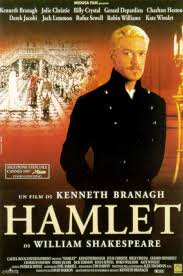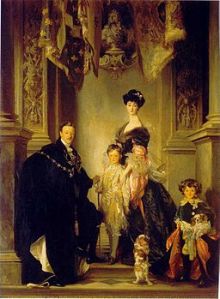Every now and then the stars align favorably. I was lucky enough to visit Blenheim Palace last fall, and doubly lucky to be in England again in the spring. When I bought my Blenheim ticket last fall, I stopped at a kiosk and made it into a year-long pass–at no extra charge! What a deal! I’d probably go back even if I didn’t like the place, but I happen to love it.
Blenheim was used for the exterior scenes of the great film Hamlet, with Kenneth Branagh as director and and playing the melancholy Hamlet himself. He was perfect. English major and Shakespeare lover that I am, I’ve watched the film quite a few times. I like to turn on the subtitles so I can get all the glorious Shakespearean words, but it is very dramatic and easy to follow even without caring much about the dialogue. It even ends with some swashbuckling worthy of Jack Bauer in 24. The acting is stellar, featuring, besides Kenneth Branagh, Charlton Heston, Julie Christie, Billy Crystal, the late Robin Williams, Derek Jacobi, Kate Winslet, Michael Maloney, Timothy Spall, Richard Attenborough, Brian Blessed, Judi Dench, Geraard Depardieu, John Gielgud, Rosemary Harris, and Jack Lemmon (he was still with us in 1996!)
Toward the end of the film, one scene shows the new King arriving after the tragic events of the story, riding up to the palace with his retinue.
The palace, decorated with military mementos of the First Duke of Marlborough, was just the right location. The 11th Duke of Marlborough had a cameo appearance as one of the nobles accompanying the new king. I’m guessing it was one of the highlights of his long and distinguished life. After all, he was appearing with fine actors in a great film that showcased his ancestral home. Plus the new King was played by Rufus Sewell, in fine smoldering form. Who wouldn’t want to appear in that film?

I last saw the 11th Duke last fall on my visit. He was usually a very visible presence, striding around his palace and really seeming to welcome visitors. When I was there last, his brother was being married in the palace chapel. So the Duke was jovially greeting his guests. He looked frail, though, and I was sad to learn that he died just a few weeks later. During my visit, I saw his lovely wife, and I also saw the soon-to-be 12th Duke with his wife. I recognized them all from photos in the house. The heir is in the photo just behind the 11th Duke.
I previously wrote about Blenheim at https://castlesandcoffeehouses.com/2014/11/06/blenheim-the-s…kings-waterloo/
I wrote about the death and funeral of the elegant 11th Duke at https://castlesandcoffeehouses.com/2014/10/30/what-are-plus-fours-anyway/ and https://castlesandcoffeehouses.com/2014/10/29/farewell-to-th…of-marlborough/
The 12th Duke has now moved to the front of the photo displays in the palace. Yesterday I toured the several of the family’s private rooms in the East Wing. The rooms are sumptuous, but lived-in. (Think of the most elegant possible version of Shabby Chic). There are 12 bedrooms, each with its own bathroom and dressing room–but they are off limits. No photos were allowed. The 12th Duke was in the house–his flag was flying. But he must not have been told that I had come to see him, because he was nowhere in sight. As an American, I’m always puzzled but intrigued by British aristocracy and royalty. I wish the 12th Duke many years of carrying on his family’s heritage, and I’m sure he’s as dedicated to the task as his late father was.
Join me next time for more explorations in the art and history of Europe and the British Isles!






























